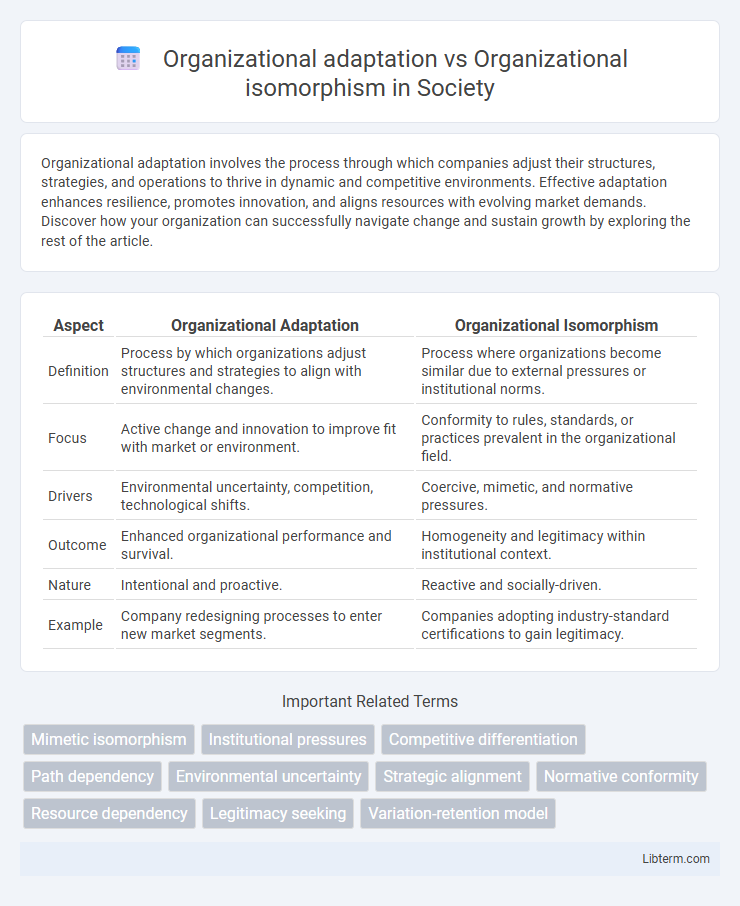Organizational adaptation involves the process through which companies adjust their structures, strategies, and operations to thrive in dynamic and competitive environments. Effective adaptation enhances resilience, promotes innovation, and aligns resources with evolving market demands. Discover how your organization can successfully navigate change and sustain growth by exploring the rest of the article.
Table of Comparison
| Aspect | Organizational Adaptation | Organizational Isomorphism |
|---|---|---|
| Definition | Process by which organizations adjust structures and strategies to align with environmental changes. | Process where organizations become similar due to external pressures or institutional norms. |
| Focus | Active change and innovation to improve fit with market or environment. | Conformity to rules, standards, or practices prevalent in the organizational field. |
| Drivers | Environmental uncertainty, competition, technological shifts. | Coercive, mimetic, and normative pressures. |
| Outcome | Enhanced organizational performance and survival. | Homogeneity and legitimacy within institutional context. |
| Nature | Intentional and proactive. | Reactive and socially-driven. |
| Example | Company redesigning processes to enter new market segments. | Companies adopting industry-standard certifications to gain legitimacy. |
Defining Organizational Adaptation
Organizational adaptation refers to the process by which organizations adjust their structures, strategies, and processes to respond effectively to environmental changes and internal challenges. It involves dynamic modifications aimed at enhancing organizational fit with varying market conditions, technological advances, and competitive pressures. Unlike organizational isomorphism, which emphasizes homogenization among organizations due to external pressures, adaptation centers on continuous evolution tailored to specific situational demands.
Understanding Organizational Isomorphism
Organizational isomorphism explains how organizations within the same environment tend to become similar due to coercive, mimetic, and normative pressures, ensuring legitimacy and stability. This concept contrasts with organizational adaptation, which emphasizes unique changes made by organizations to better fit their environments. Understanding isomorphism is crucial for analyzing why organizations conform to industry standards rather than solely innovating or differentiating themselves.
Key Differences Between Adaptation and Isomorphism
Organizational adaptation involves proactive changes made by an organization to align with evolving environmental demands, emphasizing flexibility and innovation. Organizational isomorphism refers to the process where organizations become similar due to external pressures, such as regulatory requirements or industry norms, often leading to homogenization. Key differences lie in adaptation's focus on unique internal adjustments for survival, whereas isomorphism results in conformity driven by external institutional forces.
Theoretical Foundations of Adaptation and Isomorphism
Organizational adaptation is rooted in contingency theory, emphasizing how organizations adjust structures and processes in response to environmental changes to enhance survival and performance. In contrast, organizational isomorphism, grounded in institutional theory, explains how organizations become similar over time due to coercive, mimetic, and normative pressures within their institutional environment. These theories highlight adaptation as a proactive, dynamic response versus isomorphism as a conformist process driven by legitimacy and social expectations.
Drivers of Organizational Adaptation
Organizational adaptation is driven primarily by internal pressures such as changes in technology, market demands, and resource availability, requiring firms to modify structures and processes for enhanced performance and survival. In contrast, organizational isomorphism stems from external pressures, including regulatory mandates, cultural expectations, and competitive dynamics, leading organizations to conform to industry norms and standards. Key drivers of adaptation emphasize flexibility, innovation, and proactive strategic alignment with environmental shifts to maintain competitive advantage.
Mechanisms of Organizational Isomorphism
Organizational isomorphism occurs when organizations within the same field become increasingly similar due to mechanisms such as coercive pressures from regulations, mimetic processes in uncertain environments, and normative influences stemming from professionalization. These mechanisms drive organizations to adopt comparable structures, practices, and strategies to gain legitimacy and stability. Unlike organizational adaptation, which prioritizes responses to changing environments to enhance performance, isomorphism emphasizes conformity and homogenization within institutional fields.
Impact on Organizational Performance
Organizational adaptation involves a dynamic process where firms modify strategies, structures, and processes in response to environmental changes, leading to improved organizational performance through increased efficiency and innovation. In contrast, organizational isomorphism emphasizes conformity to industry norms and practices, which may enhance legitimacy but can limit performance gains by stifling differentiation and innovation. Studies show that while adaptation drives competitive advantage via flexibility and responsiveness, isomorphism often results in homogenization that constrains long-term performance growth.
Adaptation vs. Isomorphism in Dynamic Environments
Organizational adaptation involves a firm's proactive changes in structures and processes to survive and thrive amid dynamic environments, emphasizing flexibility and innovation to meet shifting market demands. In contrast, organizational isomorphism refers to the tendency of organizations within the same field to become similar due to institutional pressures, leading to homogeneity in practices and structures. Adaptation drives competitive advantage through continuous evolution, while isomorphism promotes legitimacy and conformity, often limiting responsiveness to environmental changes.
Case Studies: Adaptation and Isomorphism in Practice
Case studies on organizational adaptation demonstrate how companies modify structures and strategies to fit dynamic environments, such as Netflix evolving its business model to digital streaming. Organizational isomorphism is observed in examples like hospitals adopting similar electronic medical records systems due to regulatory pressures and industry norms. These cases reveal adaptation as a proactive, context-driven process, while isomorphism often results from coercive, mimetic, or normative pressures leading to homogeneity across organizations.
Strategic Implications for Organizational Change
Organizational adaptation involves proactive adjustments to internal structures and processes in response to dynamic environmental factors, promoting innovation and competitive advantage. Organizational isomorphism leads entities to conform to industry norms and regulatory pressures, ensuring legitimacy but potentially limiting strategic differentiation. Balancing adaptation and isomorphism critically shapes organizational change strategies by aligning flexibility with external expectations to sustain long-term performance.
Organizational adaptation Infographic

 libterm.com
libterm.com